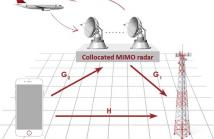
- Read more about Rate Maximization for Partially Connected Hybrid Beamforming in Single-User MIMO Systems
- Log in to post comments
Partially connected hybrid beamforming (HBF) is a promising approach to alleviate the implementation of large scale millimeter-wave multiple-input multiple-output (MIMO) systems. In this paper, we develop rate maximizing algorithms for the full array- and subarray-based processing strategies of partially connected HBF. We formulate the rate maximization problem as a weighted mean square error minimization problem and use alternating optimization to tackle it.
- Categories:
 43 Views
43 Views
- Read more about TRANSMISSION DESIGN FOR A JOINT MIMO RADAR AND MU-MIMO DOWNLINK COMMUNICATION SYSTEM
- Log in to post comments
We study a cooperative transmission scheme for a joint multiple-input-multiple-output (MIMO) radar and multi-user (MU) MIMO downlink communication system, where both systems operate on the same frequency band simultaneously. Maximization of the total weighted system mutual information or sum rate is considered with the presence of an extended target and environmental clutter. An alternating optimization based iterative algorithm is proposed to find the transmit covariance matrices for both radar and communication applications.
GlobalSIP.pdf
- Categories:
 39 Views
39 Views
- Read more about SECURITY ISSUES IN SPECTRUM SHARING BETWEEN RADAR AND COMMUNICATION SYSTEMS
- Log in to post comments
To satisfy the increasing consumer demand for mobile data,
regulatory bodies have set forward to allow commercial
wireless systems to operate on spectrum bands that until
recently were reserved for military radar. Such co-existence
would require mechanisms for controlling the interference.
One such mechanism is to assign a precoder to the communication
system, designed to meet certain interference related
objectives. This paper looks into whether the implicit radar
information contained in such precoder can be exploited by
- Categories:
 40 Views
40 Views
- Read more about Reduced Dimension Minimum BER PSK Precoding for Constrained Transmit Signals in Massive MIMO
- Log in to post comments
- Categories:
 55 Views
55 Views
- Read more about Wideband Massive MIMO Channel Estimation via Sequential Atomic Norm Minimization
- Log in to post comments
- Categories:
 35 Views
35 Views
- Categories:
 39 Views
39 Views
- Read more about Downlink Spectral Efficiency of Cell-Free Massive MIMO with Full-Pilot Zero-Forcing
- Log in to post comments
Cell-free Massive multiple-input multiple-output
(MIMO) ensures ubiquitous communication at high spectral
efficiency (SE) thanks to increased macro-diversity as compared
cellular communications. However, system scalability and performance
are limited by fronthauling traffic and interference.
Unlike conventional precoding schemes that only suppress intra-cell
interference, full-pilot zero-forcing (fpZF), introduced in [1],
actively suppresses also inter-cell interference, without sharing
- Categories:
 38 Views
38 Views
- Read more about A Novel Approach to Joint User Selection and Precoding for Multiuser MISO Downlink Channels
- Log in to post comments
The downlink capacity of a unicast network with a large number of users than the base station transmit antennas depends on user selection and interference among the selected users. Various suboptimal selection schemes in combination with suboptimal or optimal precoding have been proposed in the literature, and some of these techniques asymptotically achieve the sum capacity of DPC, as the number of users goes to infinity. In the previous works, the joint design problem is addressed as a decoupled problem of selection and precoding either at the design level or the solution level.
- Categories:
 4 Views
4 Views
- Read more about Presentation slides for GlobalSIP 2018
- Log in to post comments
In this paper, we investigate the impact of multiple-antenna
deployment at access points (APs) and users on the performance
of cell-free massive multiple-input multiple-output
(MIMO). The transmission is done via time-division duplex
(TDD) protocol. With this protocol, the channels are first
estimated at each AP based on the received pilot signals
in the training phase. Then these channel information will
be used to decode the symbols before sending to all users.
The simple and distributed conjugate beamforming technique
- Categories:
 22 Views
22 Views
- Read more about A Novel Approach to Joint User Selection and Precoding for Multiuser MISO Downlink Channels
- Log in to post comments
The downlink capacity of a unicast network with a large number of users than the base station transmit antennas depends on user selection and interference among the selected users. Various suboptimal selection schemes in combination with suboptimal or optimal precoding have been proposed in the literature, and some of these techniques asymptotically achieve the sum capacity of DPC, as the number of users goes to infinity. In the previous works, the joint design problem is addressed as a decoupled problem of selection and precoding either at the design level or the solution level.
- Categories:
 7 Views
7 Views